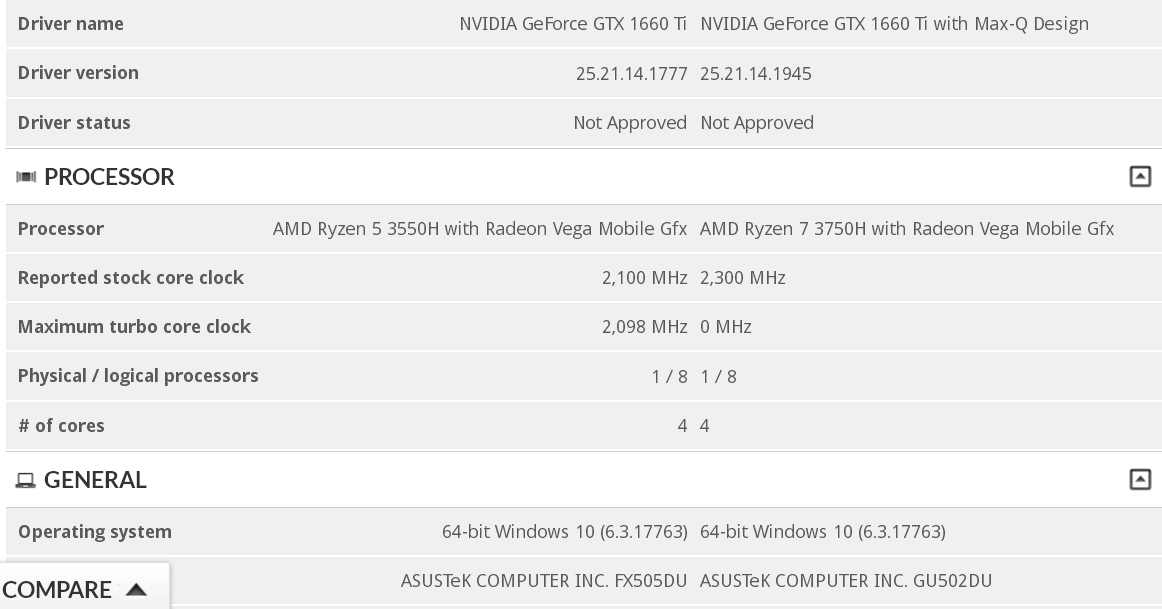In what might seem like an odd combination, AMD's AMD's Picasso APUs (accelerated processing units) have been spotted with Nvidia's Turing-powered graphics cards in Asus' upcoming FX505DU, GU502DU and GU502DV gaming laptops.
A well-known leaker called Apisak shared what looks like a 3DMark posting on Twitter Sunday.
With the release of its latest Ryzen H-series gaming chips, AMD is finally gaining favor from laptop manufacturers. According to the 3DMark leaks, Asus' FX505DU and GU502DU will feature AMD Ryzen 5 3550H and Ryzen 7 3750H, respectively. The two Ryzen 3000-series parts are expected to be based on AMD's Zen+ processor microarchitecture and fabbed by GlobalFoundries on the 12nm process node.
Based on the posting, the Ryzen 5 3550H and Ryzen 7 3750H are each equipped with four cores, eight threads, 6MB of L3 cache and a 35W TDP (thermal design power) rating. The Ryzen 5 chip clocks in at 2.1GHz with a 3.7GHz boost, while the Ryzen 7 chip features a 2.3GHz base clock and 4GHz boost clock. The first comes with AMD's Vega 10 graphics with a boost clock up to 1,400MHz, and the latter employs Vega 8 graphics with a 1,200MHz boost clock.
The Ryzen 3000-series APUs are reportedly hooking up with Nvidia's GeForce GTX 1660 Ti. This is an interesting combo, as the Ryzen APUs already come with integrated graphics and Asus is seemingly pairing them with a discrete graphics card. The Ryzen 3000-series duo are rated for 35W, which helps with lower power consumption and heat while prolonging battery life. Consumers can opt to use the integrated Vega graphics for everyday tasks and light gaming and switch to the GTX 1660 Ti for heavy gaming. According to TUM_APISAK, Asus also plans to offer the GU502DV laptop with the beefier GeForce RTX 2060.
At the time of writing, Nvidia hasn't announced a mobile (laptop) version of the GTX 1660 Ti. However, this 3DMark leak suggests there will be a Max-Q version of the GPU. Max-Q variants typically possess a reduced TDP, which allow laptop vendors to stick the graphics card into very thin gaming laptops. The tradeoff is lower clock speeds, so Max-Q versions perform significantly slower.
The thought of a AMD's Zen+ CPU microarchitecture and Nvidia's Turing GPU microarchitecture coming together certainly intrigues us. We can't wait to see the level of performance and pricing on this apparently upcoming generation of gaming laptops.
Get Tom's Hardware's best news and in-depth reviews, straight to your inbox.
MORE: CPU Hierarchy - A Comparison of AMD and Intel Processors
MORE: How to Buy the Right CPU

Zhiye Liu is a news editor, memory reviewer, and SSD tester at Tom’s Hardware. Although he loves everything that’s hardware, he has a soft spot for CPUs, GPUs, and RAM.
